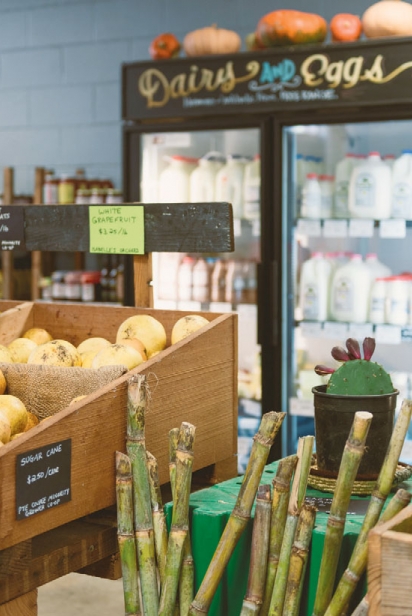Resilient Hollygrove
MARKET AND FOOD HUB FLOURISH AFTER HARD TIMES
It started as a post-Katrina dream: Turn an abandoned old nursery into a local food hub that would help get fresh, healthy food into one of our city’s most pervasive food deserts, help get local farmers paid well to grow high-quality food in sustainable ways for a customer base that they would develop relationships with, and help local families secure stable housing by reinvesting the profits through the Carrollton-Hollygrove Community Development Corporation (CHCDC) to create more affordable housing in the neighborhood.
With help from the New Orleans Food & Farm Network and the Tulane City Center, Paul Baricos, then director of the CHCDC, and his small team opened the doors to Hollygrove Market and Farm (Hollygrove) in the spring of 2009. The market, originally exclusively focused on the weekly box of regional, seasonal produce, was only open each Saturday for a few hours.
Six years later, Hollygrove is open seven days a week and nine hours a day, selling over 300 unique, locally grown or locally made products from over 115 farmers and vendor partners. The little dream of Hollygrove has grown into a well-stocked, deeply connected, and fully programmed business that sustains not only its immediate neighborhood, but a broader network of individuals, organizations and restaurants all doing kindred work.
The journey has been an arduous one, though, surviving a number of challenges thanks to its small, hardworking team of employees and volunteers.
“We have an awesome team,” General Manager Angelina Harrison told me while sitting in her spare little office above the market. “It feels a lot like the old days.”
Harrison joined the team in the spring of 2012, just a few months after moving to New Orleans. She had just graduated from the University of California, Berkeley, with a degree in environmental science, policy and management and was looking to make groceries at a CSA in her new home. She had worked in local government on climate action planning and wanted to get engaged in similar work here. So, when she stumbled across Hollygrove Market and Farm, she signed up to volunteer (nearly all of Hollygrove’s employees started as volunteers).
At the time, the market had expanded its hours to three days a week, the staff had grown to five people and the future was looking ripe with potential for expansion. The team was clicking; their restaurant wholesale and home-delivery businesses were getting off the ground; they had a burgeoning partnership with then-newcomer online grocer Good Eggs; revenues were growing steadily; and both the mentor farmers’ rows and the community garden plots were bursting with life.
A couple years later, a series of schisms would throw the whole operation into limbo. Two employees came in one morning and proposed a split to the Hollygrove board: Hollygrove would remain a retail local produce market and the two employees would take all the contacts they had built there to run a separate business for wholesale distribution to both the market and local restaurants.
The board rejected the proposal, the two employees left Hollygrove to start a new business across town. These abrupt changes happened over the course of a few short days, putting a dangerous dent in the market’s revenues, damaging long-held relationships both with suppliers and clients and leaving Hollygrove with a leadership vacuum.
The board took action, appointing an emergency manager to manage finances, biding time to recruit new leadership to help the market get back on its feet. Angelina was promoted to GM and the rest of the remaining staff stepped up to keep the doors open and rebuild the business.
It took the better part of a year, but Angelina and her team rebuilt trust with their community and partners, restarted their wholesale and home-delivery businesses, and even recruited a slew of new partners and started a handful of new initiatives.
Just as the smoke was beginning to clear and it came time for Angelina to take full control of all daily operations, she found a financial wreckage that threatened the solvency of the whole organization.
Again, it took months for Angelina and her team to sort through the paper trail and figure out a way forward. And sure enough, with the love and support of the community they had been building over the years, the team has stayed steady and kept the doors open, without a single day’s disruption of service for their loyal customers.
Now back at full steam, Hollygrove sells over 600 of their signature boxes each week, buys and sells all the produce from their mentor farmers’ plots, collaborates with partner organizations to get fresh foods to community members with diet-related health issues, and teaches community members ages 2–92 how to grow life in this city—to name just a few of their many impacts.
When asked about what challenges lie ahead for her and her team, Angelina tells me that the new Food Safety Modernization Act passed by the federal government in 2011 has provisions rolling in over the coming months that threaten the viability of her small-scale, local farmers, so the market is taking on the initiative of educating its farmer partners and helping to facilitate the shift. This also means helping communicate the value of their products to their customers with a new labeling system to help customers understand how each product is grown.
“More than anything else, though,” she says, “we need to make it super-easy for people to make the right choices for themselves and their families. It shouldn’t seem like this martyrdom to eat local.”
That commitment to service and their mission is what makes Hollygrove remarkable. So many little innovations, acts of kindness, and deep relationships have created a tiny mecca for our city’s food-wise neighbors to shop, learn and grow.
Hollygrove Market and Farm
8301 Olive St.
New Orleans, LA 70118
504.483.7037
HollygroveMarket.com





